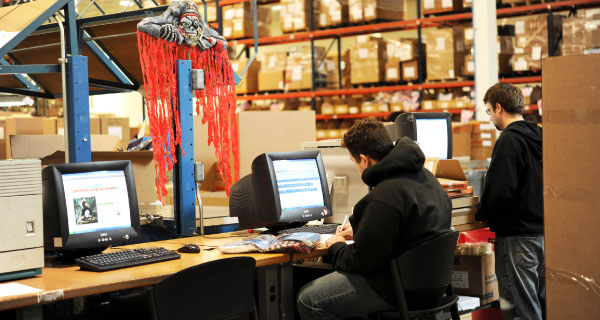Articles
Reverse Logistics

Liquidate Inventory or Leave Money on the Table
Reverse logistics programs aim to efficiently remove returned and obsolete inventory from the primary sales channel to maximize recovery values while minimizing related financial risk. Retailers and manufacturers liquidate more than 95 percent of overstock inventory and customer returns on the secondary market. When evaluating the effectiveness of their returns process, many executives focus on […]
Read More
How to Profit from Outsourcing
More companies outsource the reverse logistics function than any other part of the supply chain. In fact, most Fortune 1000 retailers and consumer goods manufacturers outsource part or all of their reverse logistics processes, and experts expect this trend to continue growing globally over the next 20 years. Why do companies such as Walmart, Dell, […]
Read More
Managing Retail Returns: The Good, the Bad, and the Ugly
Retailers have to cope with all kinds of returns—from apparel that just didn’t suit the customer, to expired products that are no longer saleable, to recalls endangering public safety. Here’s how retailers handle this range of returned goods to recover maximum value.
Read More
Global—February 2014
Serving Returning Customers In a fickle economy, retailers want consumers to be less discreet about their discretionary spending. One way they can encourage that is to make it easier for customers to return impulse buys or unwanted holiday gifts. But returns can add significant costs, especially when it involves cross-border business. Take, for example, online […]
Read More
Minimizing the Financial Impact of Peak Season Returns
As the supply chain world settles in for a long winter’s nap, the reverse logistics world is shifting into overdrive to handle peak returns season. Both retailers and manufacturers report that the percent of returns for 2014 is roughly the same as it was by this point in 2013. The rate of returns for holiday […]
Read More
Plan Early for Peak Returns Season
By late fall, supply chain executives worldwide are well prepared for the high-volume year-end holiday season. But following close behind it is peak returns season. Now is the time to plan for managing the returns, overstocks, and recalls businesses will process between mid-December and early March. During peak returns season, companies handle up to 45 […]
Read More
Putting a Lean Spin on Reverse Logistics
Reverse logistics—the processes involved with handling products returned by customers—is often overlooked during supply chain planning. As a result, it is frequently a source of waste, because companies lack Lean procedures for handling defective, damaged, mislabeled, or incorrectly shipped items when customers return them. Recently, businesses have started paying more attention to their reverse logistics […]
Read More
Discovering the Value of Reverse Logistics
Some people think of reverse logistics—the process of removing assets from their primary use channel to a secondary channel to maximize the assets’ value—as only handling customer returns or defective goods. But defective items account for only about 25 percent of the total value of all assets processed in reverse logistics operations. Recalled product, overstocks, […]
Read More
Consumer Electronics and Reverse Logistics: Play It Again
Shoppers return between 11 and 20 percent of consumer electronics devices, according to industry experts. While returns are the beginning to device recovery, all the steps in the reverse logistics process, including repair/refurbishment and remarketing, can be improved. Recognizing the importance of reverse logistics in maintaining and growing profit margins, many consumer electronics manufacturers and […]
Read More
How to Select a Returns Management Partner
As retailers turn over stones looking for ways to reduce costs, eliminate waste, become greener, and raise the bottom line, returns management is an area ripe for picking. What was once written off as a lost cost has now become a can’t-miss opportunity—and for good reason. In 2011, U.S. consumers returned more than eight percent […]
Read More
Return to Sender: Managing Reverse Logistics
Most e-commerce businesses focus time and money on providing customers with efficient and flexible delivery options. Many companies, however, neglect to extend this attention to the return of unwanted goods. While many factors influence customer loyalty, a well-run returns process drives repeat orders and improves consumer satisfaction. Eighty-five percent of consumers surveyed by research firm […]
Read More
Reusable Shipping Dunnage Protects Sustainability Efforts
Containers and packaging account for 30 percent of all U.S. municipal solid waste, according to a 2009 EPA study. Small wonder, considering the contribution of millions of tons of disposable corrugated and wood filler used to protect products in transit across America every day. By road and rail, goods move about in the temporary company […]
Read More
Improving Reverse Logistics Moves Shippers Forward
Q: How can shippers improve their reverse supply chain? A: Amid today’s higher fuel and transportation costs, technology becomes critical as companies search for efficiencies within the supply chain. The reverse supply chain has historically been viewed as a cost center and is often overlooked as a place where profit can be found. In the […]
Read More
Co-locating Reverse and Forward Logistics Unlocks Value of Returns
Q: Why is reverse logistics an important function in today’s consumer electronics supply chain? A: Companies are trying to extend product lifecycles, as well as maximize asset recovery value. If they spend money to make a product, they want to recapture as much of the original cost as possible. Consider that 65 to 70 percent […]
Read More
The Three Pillars of Effective Returns Management
Returns management presents both challenges and opportunities for inbound logistics. Waste management regulations and non-compliance penalties are increasing. Rising commodity prices and a growing secondary marketplace, however, create an opportunity to recover value from used and scrapped materials. A cost-effective reverse logistics program connects the incoming supply of returns with the product information and demand […]
Read More
Reverse Logistics: The Untapped Revenue Stream
Reverse logistics has become an area of high priority for companies looking to reduce costs, add efficiencies and improve the customer experience. As a result, manufacturers are uncovering the hidden value of returned assets and streamlining return, repair and product reallocation processes. Once a supply chain afterthought, reverse logistics has evolved into a highly complex […]
Read MoreHumanitarian Aid: The Logistics of Doing Good
Nonprofit organization MedShare distributes recovered medical supplies to the places of greatest need.
Read More
Green Reverse Logistics Brings Many Happy Returns
Companies that combine the “reduce, reuse, recycle” mantra with the supply chain wisdom of managing costs and stamping out inefficiencies are developing reverse supply chains that help the Earth, the customer, and the bottom line.
Read MoreProactive Returns Management Yields Hard ROI
Multi-channel product distribution and stiff competition for more demanding and discerning customers require creative strategies for managing and maintaining customer relationships. As companies search for areas of opportunity to meet these needs, returns management tops the list.Product returns and their impact on a company’s bottom line is an age-old problem. The complexities of reverse product […]
Read MoreGetting Started in Reverse Logistics
An integrated approach to reverse logistics can improve customer satisfaction, reduce costs, drive continuous improvement, and maximize return on assets.
Read More